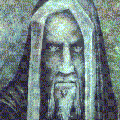
Celtic Society
Unfortunately, Julius Caesar is our best source of information about Celtic society and this evidence is supplemented -as well as objected!- by archaeological remains.
The Celts were generally governed by a council of nobles and by powerful chiefs like Caesar's most dangerous Celtic adversary, Vercingetorix. Caesar thought the ordinary people to be "treated almost as slaves". They were impoverished and oppressed and bound themselves to the service of powerful men in order to survive. If the leader of a faction failed to protect his followers, however, he became completely discredited. There were two privileged classes, the Druids who seem to have combined the roles of priest and magistrate, and the Knights who led the people in war.
 The Druids officiated at religious ceremonies and were consulted on all aspects of the worship of the gods. They normally elected a chief Druid but sometimes rival factions fought for their preferred candidate. They met every year to decide legal disputes and were held in high regard. Caesar reported that Druidism had its roots in Britain and that students would travel there for instruction. He heard that their religion forbade them from writing about it and that it was transmitted in verse. There were so many verses that Druids might have to spend twenty years learning them. The Druids officiated at religious ceremonies and were consulted on all aspects of the worship of the gods. They normally elected a chief Druid but sometimes rival factions fought for their preferred candidate. They met every year to decide legal disputes and were held in high regard. Caesar reported that Druidism had its roots in Britain and that students would travel there for instruction. He heard that their religion forbade them from writing about it and that it was transmitted in verse. There were so many verses that Druids might have to spend twenty years learning them.
Before Caesar's intervention the Gauls used to fight wars every year and the Knight's importance would be reckoned by the number of his servants and warriors. Caesar noted that areas furthest from the Roman Province produced the fiercest soldiers and implies that certain parts of the Celtic world had been enervated by exposure to imported Roman luxuries.
Women had few rights but enjoyed a certain degree of security. If a woman were to marry, the husband would match her dowry with property of an equal value. If one of the partners were to die, the survivor would inherit this property and any profits earned. Funerals were considered a great event, the dead were cremated on a funeral pyre together with their favourite objects and at some time in the past, slaves and retainers had been burnt with their masters.
The Celts lived on small farms or in villages but could retreat when threatened to the comparative safety of a hill fort. These hill forts were constructed by digging a ditch around the top of suitable hills (or around other natural features which were easy to defend). Timber or dry stone walling was used to contain the rampart material and some of these forts had quite complex works to protect their entrances. Some hill forts are found to have remains of buildings but others have none and there is some debate about how they were used in ancient times. Domestic timber housing could be square, rectangular or circular in plan. In Britain circular houses were more common.>
The Celts had a coinage more than a century before their lands became part of the Roman empire. Hundreds of thousands of coins have been found and some of these have given us information on otherwise unknown rulers. The earliest found in Britain were of pure gold and imitated the stater of Philip of Macedon. Philip made use of Celtic mercenaries and this might explain the existence of these coins in Britain.
Celtic coins often featured pictures of horses, boars and ears of wheat. For low value coins, the Celts used an alloy of copper and tin called "potin". Coins of this type were ultimately cast in long strips and they continued in circulation until the first century CE. The coin illustrated above is a stater of Cunobelin from the period 10 to 40 CE.
Celtic mythology, which included earth gods, various woodland spirits, and sun deities, was particularly rich in elfin demons and tutelaries, beings that still pervade the lore of peoples of Celtic ancestry.
Celtic Christianity
|







